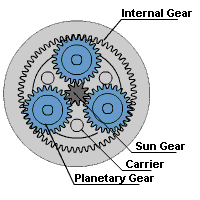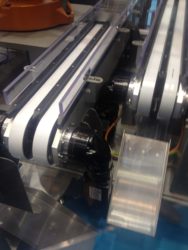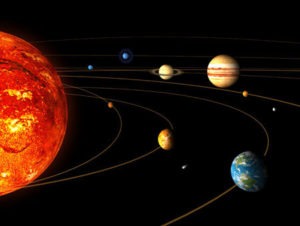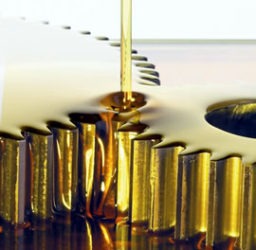What is a planetary gearbox?
 What millennial-old technique is the basics of many of the most innovative technical breakthroughs of this moment? Robotics, 3D printing and new means of transport all have one thing in common: often they are driven by a planetary gearbox. As a supplier of planetary gearboxes, of course we know all ins and outs, but what if you encounter this technique for the first time? We have decided to explain it clearly for all – In this article we discuss the basics of the planetary gearbox.
What millennial-old technique is the basics of many of the most innovative technical breakthroughs of this moment? Robotics, 3D printing and new means of transport all have one thing in common: often they are driven by a planetary gearbox. As a supplier of planetary gearboxes, of course we know all ins and outs, but what if you encounter this technique for the first time? We have decided to explain it clearly for all – In this article we discuss the basics of the planetary gearbox.
What is a planetary gearbox?
A planetary gearbox is a gearbox with the input shaft and the output shaft aligned. A planetary gearbox is used to transfer the largest torque in the most compact form (known as torque density).
The bicycle’s acceleration hub is a great example of a planet-wheel mechanism: Have you ever wondered how you can get so much power and capabilities in such a little hub? For a three-speed hub, a one-stage planetary gear system is used, for a five-speed hub a 2-stage. Each planet gear system has a reduction state, a direct coupling and an acceleration mode.
In mathematical terms, the smallest reduction ratio is 3: 1, the largest is 10: 1. At a ratio of less than 3, the sun gear becomes too big against the planet gears. At a ratio greater than 10 the sun wheel becomes too small and the torque will drop. The ratios are usually absolute i.e. an integer number.
Whoever invented the planetary gearbox is not known, but was functionally described by Leonardo da Vinci in 1490 and has been used for centuries.
Why is it named a planetary gearbox?
The planetary gearbox got its name because of how the different gears move together. In a planetary gearbox we see a sun (solar) gear, satellite (ring) gear and two or more planet gears. Normally, the sun-gear is driven and thus move the planet gears locked in the planet carrier and form the output shaft. The satellite gears have a fixed position in relation to the outside world. This looks similar to our planetary solar system and that is where the name comes from. What helped was that ancient gear constructions were used extensively in astrology for mapping and following our celestial bodies. So it was not such a big step to make.
In practice, we often speak from the perspective of the use of planetary gearboxes for industrial automation. That is why we call the sun-gear the input shaft, the planet gears and carrier the output shaft and the satellite gear (or ring gear) the housing.
Possibilities of planetary gearboxes
It is possible to realise different speeds and turning directions with the same construction. This can be achieved by, for example reversing the gearbox, which offers the following possibilities:
| Driven side | Solid world | To be driven side | Result |
| Input shaft | Housing | Output shaft | Reduction |
| Input shaft | Output shaft | Housing | Reverse movement + Delay |
| Output shaft | Input shaft | Housing | Delay |
| Output shaft | Housing | Input shaft | Acceleration |
| Housing | Output shaft | Input shaft | Reverse movement + Acceleration |
| Housing | Input shaft | Output shaft | Delay |
| In- and output shaft | N.A. | Housing | 1:1 |
Where is the planetary gearbox usually used (in the transmission)?

- In a robot to increase the torque
- In a printing press to reduce the speed of the rollers
- For precise positioning
- In a packaging machine for a reproducible products
Buying a Planetary Gearbox: What should you pay attention to
What are the purchase criteria for a planetary gearbox? That is a difficult to answer question, because it is highly dependent on where the gearbox is used precisely. First of all, the primary specifications (eg.: torque, backlash, ratio) must be correct, but then the secondary (eg.: corrosion resistance, noise level, construction) and the tertiary (eg.: delivery time, price, global availability, service) are important.
Because Apex Dynamics runs faster, you can contact us for all your questions. We will reply fast, often the same day, with a customised response and/or customised offer. This way, you never have to worry about a delay, we deliver every gearbox out of stock and faster than anyone else.
Grease or oil as lubricant in planetary gearbox
Even with how precisely the planetary gearbox is manufactured and assembled, there are always rolling or sliding surfaces inside. That’s why each gearbox contains a lubricant – whether it’s oil, grease or a synthetic gel – to ensure the gears function well and prevent wear. In addition, the lubricant often also provides cooling and reduces noise or vibration. Apex Dynamics uses a special lubricant from the company Nye Lubricants, in fact it is a kind of gel.
We published an article about this subject:
SMART Lubrication: Without lubricant no smooth gear!
6 arguments for a planetary gearbox in combination with a servo motor
- The torque is divided over 3 gears (the planet gears), and therefore – at equal dimensions – the torque is almost 3-fold than a “normal” gearbox.
- Low backlash.
- Compact and therefore a low mass inertia.
- High efficiency.
- Closed system.
- Absolute ratios between 3: 1 and 10: 1 per stage.
Why a planetary gearbox from Apex Dynamics
Apex Dynamics gearboxes are ideal for, for example, modern-day servo technology, thanks to the sophisticated Viton seals, helical teeth and a balanced sun-gear shaft. We carry about 49 product series of planetary gearboxes and offer unrevealed service, support and local stock. That makes us an unbeatable supplier of low-backlashes gearboxes.






